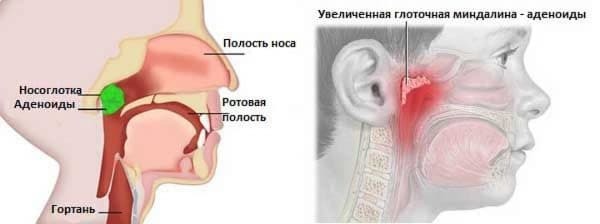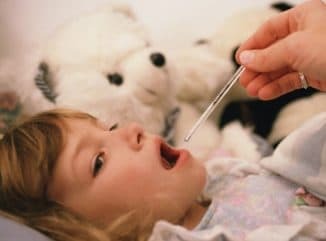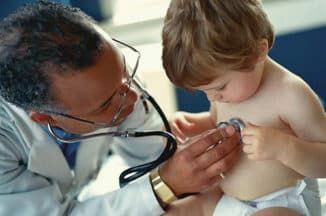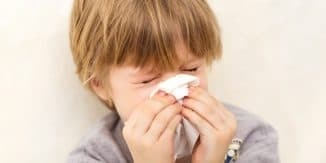
Very often children suffer from such an unpleasant disease as adenoit. Fortunately, this ailment can be cured quickly enough if time is taken. But in the case of triggering the disease adenoit can lead to unexpected and unpleasant consequences.
Many parents even underestimate all the harm that untreated adenitis can bring to the health of their child. In this article, we will examine the peculiarities of this disease, find out what stages and symptoms it has, how to treat pathology, listen to the feedback of parents whose children have successfully overcome adenitis.
Contents
- 1 Description of the disease
- 2 Reasons
- 3 Stages and symptoms
- 3.1 First
- 3.2 Second
- 3.3 Third
- 4 Treatment
- 5 Prevention
- 6 Reviews
Description of the disease
Adenoit is a disease that affects the nasopharynx of the lymphatic tissue. In simple terms, it is the proliferation of connective tissue of the nasopharyngeal mucosa. Sprawl this leads to numerous problems, the main of which is the inability to breathe normally. Due to illness, the tissues swell and block the airways. As a consequence, the baby can not breathe normally, breathe freely, and other, equally unpleasant symptoms appear.

In the photo, adenoiditis in children looks like
Tonsils that are located in the nasopharynx are a natural obstacle and a shield in the way of penetration of microbes and viruses into the child's body. When a person grows up, tonsils cease to perform their protective functions, since the immunity of an adult is already strong. However, children need such protection, and during adenitis tonsils become inflamed, ceasing to perform their functions.
Inflamed tonsils expand at times to such an extent that the passage in the nasopharynx completely overlaps. This is already happening, as a rule, at the third stage of the development of the disease.
Pediatrician Komarovsky says that adenoiditis is a very serious problem for children. In some cases, it can lead to really serious complications.
On video adenoiditis in children, the symptoms of Dr. Komarovsky:
Reasons for

Let's find out why children have this unpleasant disease
The most common cause is the appearance of adenitis after a child's infectious diseases. Among others it can be tonsillitis, whooping cough, measles, and even banal ARVI.In this case, adenoma is a complication of one of these diseases, as a result of untimely or incorrect treatment.
The pediatrician Komarovsky one of the reasons of adenitis calls still the wrong nutrition of the child. As a result of the fact that too hot or too cold pieces of food or drinks get on the mucous larynx, inflammation of the mucous membranes arises, which then leads to adenitis.
If the child is overfed, this can lead to a malfunction of the respiratory system. And there adenitis is quite possible.
Too dry air in the baby's room sometimes leads to adenitis. Parents are advised to closely monitor the maintenance of a normal microclimate in the room where the child is. In this case, problems with the respiratory system can be completely avoided.
Sometimes the cause is a genetic predisposition. If this disease was suffered in due time by relatives, the likelihood of its occurrence in the child is increased.
Among the reasons, some pediatricians also include a sluggish thyroid gland. Also, because of this pathology, children are overweight. Allergies to certain foods, pollen and other pathogens may also become an indirect cause of childhood adenitis.
 How is the treatment of deafness due to adenoids folk remedies, will help to understand this article.
How is the treatment of deafness due to adenoids folk remedies, will help to understand this article.
Why there is acute adenoiditis, and what medicines can get rid of this problem, will help to understand this information.
It will also be interesting to know how to treat adenoids of 2nd degree in a child: http: //prolor.ru/n/ detskoe-zdorove / adenoidy-2-stepeni-u-detej-lechenie.html
It will also be interesting to learn how to cure adenoids folk remedies,and what means are the best.
Stages and symptoms of
A reliable sign that adenitis in a child can be that a baby often catches a cold without reason. No matter how hard he is, no matter how much he protects, even if he does not attend a kindergarten, he still manages to catch a cold somewhere. If you notice abnormally frequent colds of the child, this is an occasion to sound an alarm - most likely, he has adenitis. We urgently need to go to the pediatrician for an appointment.
There are three main stages in pediatric adenitis, each of which has its own characteristics and signs. Let us consider them in more detail.
First
At the very beginning of the development of pathology, the child begins to breathe noisily. Attentive parents, as a rule, always notice the problems with breathing that have begun. 
The baby's nose is increasingly pawning. Moreover, this stuffiness is not related to the common cold, there are no secretions. In a dream the child keeps his mouth open, it happens involuntarily, as he does not have enough nasal breathing.
Second
If the first stage has passed and the treatment measures have not been taken, the child enters the second stage of adenoid development.
Breathing becomes hoarse, rapid. Particularly characteristic of noisy and heavy breathing during sleep of the baby. Some children also snore at the same time.
A child complains of drying out his mouth, often drinking. Periodically he coughs, clears his throat without phlegm. Sometimes the second degree of adenitis is overshadowed by otitis or even worse hearing.
Third
This is the peak of the development of the disease. The symptoms here are the heaviest, and it's simply impossible not to notice them.
At this stage, the child does not breathe at all, only through the mouth. This causes the baby a lot of discomfort. The mouth is open most of the time, you can tell, always. 
The child often coughs for no apparent reason. Restless sleep and periodic sharp spills become constant companions of the baby and a headache for his mother. In addition, at this stage, there is a marked increase in cervical lymph nodes.
All pediatricians, including well-known Komarovsky believe that to treat children's adenitis is necessary immediately after the onset of his first symptoms. At an early stage of pathology, you can cope with it much easier and faster.
Treatment of
Let us find out by what methods one can cope with an unpleasant disease.
Pediatrician Komarovsky believes that in the first and second stages adenitis is best treated at home under the watchful eye of relatives. And with the obligatory thorough observance of all the recommendations of the doctor.
In order to quickly and effectively cope with ailment use both medicines and methods of non-traditional and traditional medicine. But the latter should be used only as an addition to the basic, traditional treatment.
The main treatment is usually rinsing the nasopharynx. To do this, apply special solutions with salt. The child should be laid on his side and in each nostril, drip a few drops of the solution. Usually grabs two. To properly dose the number of drops most often use a syringe without a needle. Well, or the usual pipette. Burying the solution, it is necessary to ensure that it does not flow out immediately, but for some time has been inside, washing the nasopharynx.
On video, how to identify and treat adenoids in a child:
To remove puffiness and to remove inflammation in the nasopharynx, special preparations are used. After a while, the child will be able to breathe freely. These are such drugs as Protaogol, Collargol or Lymphomyosot.
An important feature: Bury these drugs regularly, as for a long time, unfortunately, they do not remove puffiness, but they give a significant temporary improvement in the condition.
In addition to special solutions pediatricians are also recommended to instill in the nasopharyngeal oil of medicinal plants. Tea tree oils, as well as thuja, are especially suitable.
For the treatment, special inhalations of are often used. 
Many drugs with antimicrobial, antihistamine, anti-inflammatory and other beneficial effects are used as a solution for them. Inhalations are good in that they greatly facilitate the condition of the baby. Including they contribute to the restoration of free breathing, moisturize the over-dried nasopharyngeal mucosa, soften the larynx. After using this remedy the child sleeps better, coughs less, his breathing becomes more even, clean, without wheezing.
Sometimes the pediatrician prescribes ultraviolet irradiation. This physiotherapy has a beneficial effect on the child's condition, since the purple rays kill germs perfectly and help the body cope with viruses.
It will also be interesting to know about what to wash the nose with adenoids in children.
And here is how the treatment of inflammation of adenoids in children takes place, and what is the best medicine is described in detail in the article.
What are the reviews about using Lugol in adenoids in children, you can find out by reading the contents of this article.
And that's why a child does not breathe a nose in adenoids, and how to correctly and quickly produce a treatment will help to understand the information from this article.
It will also be interesting to learn about how chronic adenoiditis is treated.
Prevention
What measures can be taken to prevent the adolescence from appearing in the child.
You must regularly take walks in the fresh air. In the conditions of constant sitting in the room the child is not tempered, it is necessary to give him such an opportunity. In addition, clean street air, especially if you go to a park or similar environmentally friendly place, can saturate your baby's body with oxygen and give him free breathing. Walks are useful not only for the prevention of adenitis, but for all the organs and systems of the baby, improves overall its development. 
Run a wet cleaning routine on the regular basis of the room where the child is. The usual wiping of surfaces from dust can do wonders, as it destroys many bacteria and refreshes the air.
The air in the child's room must be moist. Use a humidifier or steam generator for this. In the absence of these devices, you can simply sprinkle water from the spray gun periodically.
Ventilate the room. The air in the room should not be stale and suffocating.
Reviews
What mothers say, whose children have suffered adenitis.
- Olga, 29, Petersburg: "My son is 4 years old. Since his two years, I began to notice that he was noisy, he was breathing heavily, became restless, often woke up at night. Have addressed to the pediatrist, to us have put an adenitis of the second stage. They were treated with medicines, did procedures, inhalations. Before the operation, fortunately, did not reach: thanks to the treatment the child was able to breathe normally. Now here half a year as there are no disturbing signs, I am glad. I think we managed to cope with adenitis completely. It may be advisable not to run the disease - in this case it is much easier to be treated and transferred. "
- Tatiana, 43, Penza: "My daughter is 7 years old. The last two years she has adenitis. The disease began after the angina. At first they thought that it was the echoes of the old disease, only after a while they found out that she had adenitis and needed to be treated. Due to the fact that the therapy was not started immediately, we had to remove the adenoids, since the treatment did not help. Her daughter suffered a very good operation. After her, she became less sick with cold infections, now feels fine, breathes fully. "
Result: note that children's adenitis is certainly not fatal, however, a rather unpleasant disease. The main thing is to treat it on time without starting it. And then with adenitis can quickly cope without the need for surgical intervention.
